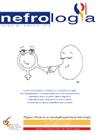Cardiovascular risk assessment: Missing albuminuria contributing to gender inequality
IF 2
4区 医学
Q2 UROLOGY & NEPHROLOGY
引用次数: 0
Abstract
Introduction
Chronic kidney disease (CKD) is associated with high cardiovascular disease (CVD) risk, and requires specific interventions to decreases CVD risk.
The guidelines indicate that systematic global CVD risk assessment is recommended in individuals with any major vascular risk factor. The European Society Cardiology (ESC) guidelines, he European Renal Association (ERA) Council and the Spanish Society of Nephrology (S.E.N.) in collaboration with 15 Scientific Societies recommend assessing albuminuria in all these populations.
We have evaluated current clinical practice regarding the assessment of CVD risk factors (blood pressure, albuminuria, serum cholesterol, glycemia and creatinine) in different adult health user populations, analyzing the results separately for men and women, given recent evidence on gender differences in the recognition, monitoring, and management of CKD.
Methods
Observational, retrospective, non-interventional single center study performed in a hospital using Electronic Health Record (EHR) data.
Results
Among 707,493 healthcare users, 612,619 were adults, and of these 332,943 (54.3%) females; 73,632 (12.0%) had DM and 121,445 (19.8%) hypertension. Mean (SD) age was 68.91 ± 21.4 years; 261,694 (36.9%) were older than 50 years.
Only 8522 (1.39%) had undergone albuminuria testing as compared with 264,684 (43.21%) tested for serum creatinine, 140,492 (22.93%) for serum cholesterol, 263,381 (42.99%) for serum glucose, and 226,448 (36.96%) for blood pressure. Albuminuria was the only cardiovascular risk factor assessed more frequently in men than in women.
Albuminuria, as other CVD risk factors, was more frequently assessed in patients with DM (6.71% of patients) or hypertension (4.81%), but albuminuria assessment remained suboptimal compared with 58–87% for other cardiovascular risk factors. For adults with diabetes or hypertension, albuminuria was assessed more frequently in men than in women.
Albuminuria assessment in those older than 50 years was also suboptimal at 2.24%, as compared with 31–47% for other CVD risk factors.
Albuminuria and EGFR are needed to screen for CKD, meaning that a urine test for albumin and creatinine and a serum test for creatinine are needed. To these, we may add assessment of blood pressure, serum cholesterol (for familial hypercholesterolemia) and serum glucose for Diabetes. Albuminuria was the only cardiovascular risk factor that was assessed more frequently in men (up to nearly 60% more frequently), indicating that screening for CKD and CVD risk in women is suboptimal. This result is surprisingly consistent across time and in all age groups. This is the first time that gender disparities in the assessment of albuminuria have been revealed.
Conclusion
Albuminuria is assessed infrequently, even in patients with a high cardiovascular risk, especially in women.
心血管风险评估:蛋白尿缺失导致性别不平等
慢性肾脏疾病(CKD)与高心血管疾病(CVD)风险相关,需要特定的干预措施来降低CVD风险。指南指出,建议对具有任何主要血管危险因素的个体进行系统的全球心血管疾病风险评估。欧洲心脏病学会(ESC)指南、欧洲肾脏协会(ERA)理事会和西班牙肾脏学会(S.E.N.)与15个科学学会合作,推荐在所有这些人群中评估蛋白尿。我们评估了目前在不同成人健康用户人群中关于心血管疾病危险因素(血压、蛋白尿、血清胆固醇、血糖和肌酐)评估的临床实践,分别分析了男性和女性的结果,并给出了CKD识别、监测和管理方面的性别差异的最新证据。方法采用电子病历(EHR)数据在某医院进行观察性、回顾性、非介入性单中心研究。结果707,493名医疗服务使用者中,成人612,619人,其中女性332,943人(54.3%);糖尿病73,632例(12.0%),高血压121,445例(19.8%)。平均(SD)年龄68.91±21.4岁;50岁以上261694例(36.9%)。只有8522人(1.39%)接受了蛋白尿检测,而血清肌酐检测264,684人(43.21%),血清胆固醇检测140,492人(22.93%),血清葡萄糖检测263,381人(42.99%),血压检测226,448人(36.96%)。蛋白尿是唯一一个在男性中比在女性中更频繁地被评估的心血管危险因素。与其他心血管危险因素一样,蛋白尿在糖尿病患者(6.71%)或高血压患者(4.81%)中被评估的频率更高,但与其他心血管危险因素(58-87%)相比,蛋白尿的评估仍不理想。对于患有糖尿病或高血压的成年人,男性蛋白尿的评估频率高于女性。50岁以上人群的蛋白尿评估也不理想,为2.24%,而其他心血管疾病危险因素为31-47%。筛查CKD需要蛋白尿和EGFR,这意味着需要进行尿液白蛋白和肌酐试验以及血清肌酐试验。除此之外,我们还可以增加血压、血清胆固醇(用于家族性高胆固醇血症)和糖尿病的血清葡萄糖的评估。蛋白尿是唯一在男性中评估频率更高的心血管危险因素(高达近60%),这表明女性对CKD和CVD风险的筛查并不理想。令人惊讶的是,这一结果在不同的时间和所有年龄组中都是一致的。这是首次发现蛋白尿评估中的性别差异。结论蛋白尿很少被评估,即使在心血管疾病高危患者中,尤其是女性。
本文章由计算机程序翻译,如有差异,请以英文原文为准。
求助全文
约1分钟内获得全文
求助全文
来源期刊

Nefrologia
医学-泌尿学与肾脏学
CiteScore
3.40
自引率
7.70%
发文量
148
审稿时长
47 days
期刊介绍:
Nefrología is the official publication of the Spanish Society of Nephrology. The Journal publishes articles on basic or clinical research relating to nephrology, arterial hypertension, dialysis and kidney transplants. It is governed by the peer review system and all original papers are subject to internal assessment and external reviews. The journal accepts submissions of articles in English and in Spanish languages.
 求助内容:
求助内容: 应助结果提醒方式:
应助结果提醒方式:


